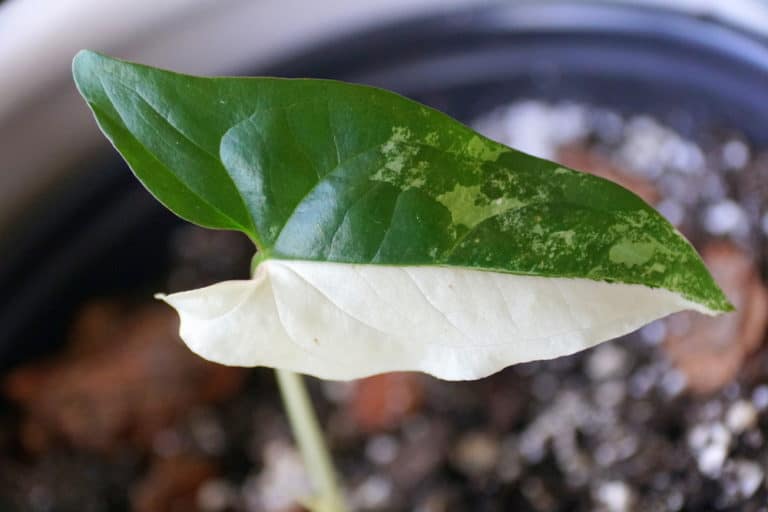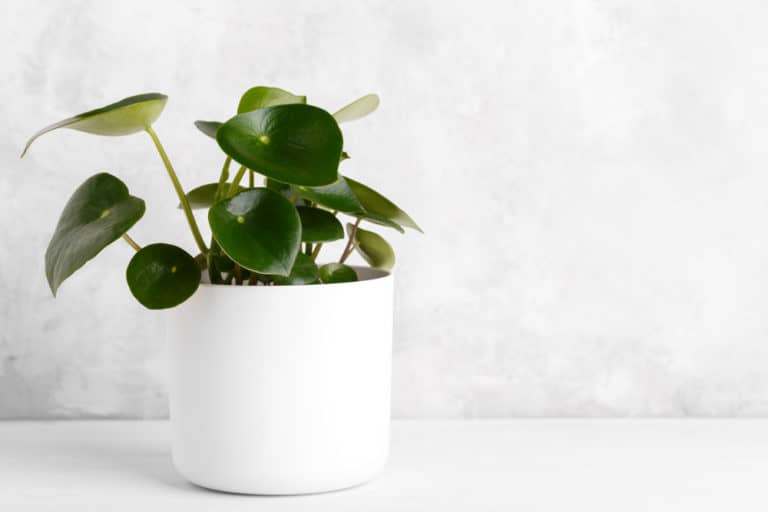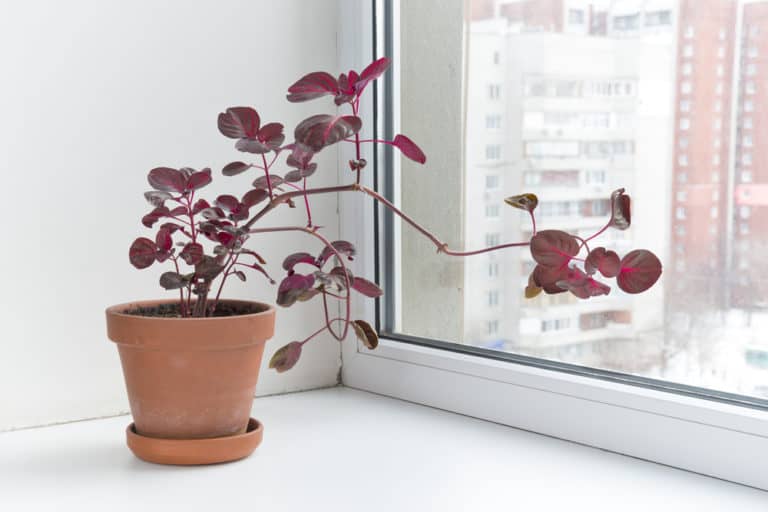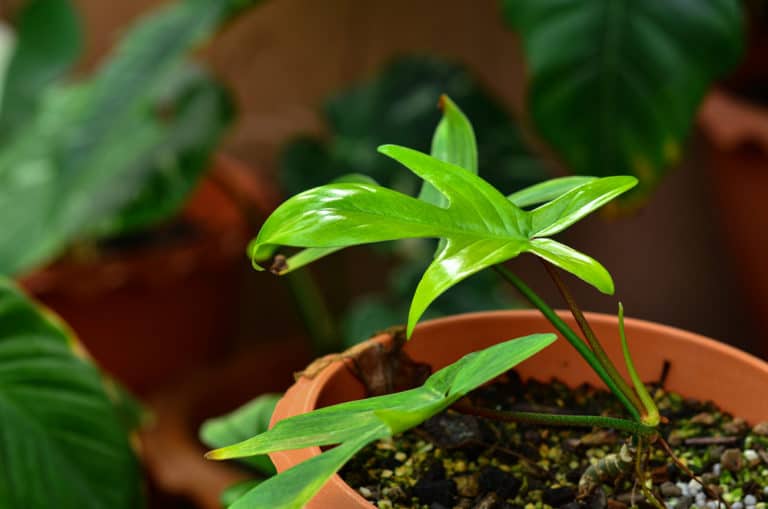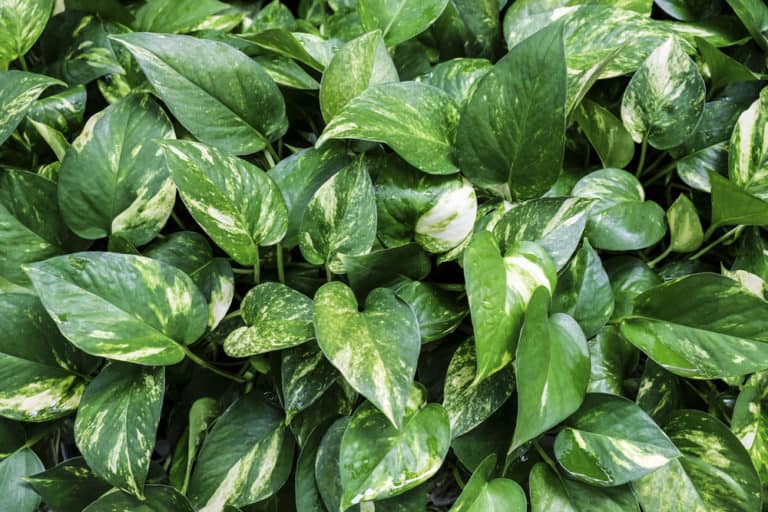Tradescantia Spathacea ‘Moses in the Cradle’ Care (2024)

Moses in the Cradle has been a much-loved houseplant for a couple of centuries.
Previously called Rhoeo spathacea, its scientific name is now Tradescantia spathacea.
Between its bright, evergreen leaves and its charming flowers, it’s a compact plant that will brighten even a small space. And it’s easy to care for!
| Scientific Name | Tradescantia spathacea |
| Common Name | Moses in the Cradle, Oyster Plant, Boat Lily |
| Light | Bright indirect sunlight |
| Watering | Water if top inch of soil is dry |
| Temperature | 65 to 86ºF (18 to 30ºC) |
| Hardiness Zone | 9 to 12 |
| Humidity | 70% |
| Soil Type | Rich, quick-draining, loamy |
| Soil pH | 5 to 6 (acidic) |
| Fertilizing | A balanced feed once a month in spring and summer |
| Repotting | Every 2 years |
| Pruning | Beginning of the growing season |
| Propagation | Division or stem cuttings |
| Toxicity | Toxic to humans and pets |
| Mature Size | 6 to 12 inches as a houseplant |
| Bloom Time | All year |
What’s Unique About Moses in the Cradle?
The Moses in the Cradle plant is native to southern Mexico, Belize, and Guatemala, where it grows in the tropical rainforests on the forest floor.
Moses in the Cradle plants got their common name because of the unique flowers that can bloom at any time of the year. The small white flowers bloom within a bract that looks like a little boat.
Its foliage is the main attraction, though, as the brilliant green and purple leaves will add a pop of color to your home or office.
Growing Moses in the Cradle is very easy, so it’s a good plant for beginner gardeners.
Moses in the Cradle Care
Tradescantia spathacea originates in the hot and humid rainforests of Central America, and you need to provide the essentials of that environment for your Moses in the Cradle plant care.
The main things to focus on for good Tradescantia spathacea care are warm temperatures, high humidity, moist soil, and bright but indirect light.
Light
While Tradescantia spathacea grows in the dappled shade of the tree canopy in its native Central American rainforests, the sunlight that is being filtered is very hot and bright.
So, while your Moses in the Cradle won’t handle full sun, Tradescantia spathacea light needs are still for bright but indirect light. That’s between 10,000 and 20,000 lux.
Your Moses in the Cradle light requirements are best met with a spot on an east or north-facing window ledge, where they will get lots of morning light.
If you have to grow it in a room with a south or west exposure, place it where the direct rays of the sun can’t touch it.
You can also use a grow light if you don’t have a bright enough location.
Watering
In its native habitat, Tradescantia spathacea gets a lot of rain in summer and fall, and very little in winter. In late winter and early spring, it may only rain once a week, while September sees rain every other day.
You should follow this seasonal variation when for your Moses in the Cradle watering. In spring, summer, and fall, water Tradescantia spathacea whenever the top inch of soil dries out.
However, its watering needs change in winter, when it is not actively growing and the soil can dry out more between waterings.
If you water too often you run the risk of your Tradescantia spathacea developing root rot.
Temperature
In the rainforests where Tradescantia spathacea originates, it’s hot. Average daytime highs range from 84 to 91ºF (29 to 33ºC), and lows go from 68 to 79ºF (20 to 26ºC).
The recommended Moses in the Cradle temperature range is 65 to 86ºF (18 to 30ºC).
You should be able to provide a suitable temperature for Tradescantia spathacea in any living space.
Of course, you won’t want to keep your home as hot as the top end of that range. However, in the hot summer you can move your Tradescantia spathacea outside to a shady spot.
Your biggest concern indoors should be keeping it out of drafts and away from cold windows in winter, as it doesn’t have much temperature tolerance below 55ºF (13ºC).
Never let it freeze, as it has no frost hardiness.
Humidity
The rainforests of Central America have 80 to 90% humidity all year long.
In your home, the ideal humidity for Tradescantia spathacea is around 70%, but you can start by trying your Tradescantia spathacea out at a normal indoor humidity level of around 40%.
However, if you start to see brown tips on the leaves, you will need to create a moist microclimate to satisfy your Moses in the Cradle humidity requirements.
You could put your Tradescantia spathacea in a bathroom, or group all your plants together and set the pots on wet pebble trays.
Misting is not usually recommended as the foliage should not get wet.
In the long run, getting a small humidifier to keep all your humidity-loving plants happy is the best solution.
Soil
The soil on the rainforest floor is loose and porous, with plenty of decaying organic matter, and your Moses in the Cradle soil should have a similar structure.
While it will not tolerate wet soil, it does require consistent moisture. It also needs a soil that both drains well and lets the roots breathe.
The recommended pH level for Tradescantia spathacea is 5 to 6, or acidic.
You can use commonly available ingredients to make your own soil for Tradescantia spathacea.
Use equal parts of peat moss, perlite, and potting soil or compost for a good soil mix to support healthy growth.
Fertilizer
You should use a moderate amount of Moses in the Cradle fertilizer, but don’t overdo it.
Use a standard indoor houseplant liquid fertilizer for Tradescantia spathacea with a balanced fertilizer ratio of 10-10-10.
Dilute it to half strength and pour it slowly and evenly over the soil surface right after you’ve watered, no more than once a month.
Only apply fertilizer in spring and summer when your Tradescantia spathacea is actively growing.
If you see a build-up of fertilizer salts on the soil surface, flush the soil by running a gentle stream of water through it for several minutes, and then wait at least a month before using more fertilizer.
Potting & Repotting
There are a couple of reasons for repotting Tradescantia spathacea.
The most pressing reason is, of course, if your plant is outgrowing its current pot. You will know that it’s time for Moses in the Cradle repotting when the roots start growing out of the drainage holes and the plant has filled the entire pot.
The other reason is to replace the potting soil, which may have become compacted and is no longer draining well.
You won’t have to increase the pot size if you are dividing your Tradescantia spathacea at the same time, but if you do, only go up to the next size.
Use a plastic or glazed pot, both of which will retain moisture better, but it has to have drainage holes.
Pruning
The only really necessary Moses in the Cradle pruning is to trim off dead or damaged leaves. They can harbor pests or disease, and make your Tradescantia spathacea look untidy.
However, you can also prune it every spring to produce a bushier shape. Indoors, do not remove more than a tenth of its foliage in any one growing season. Pinch the growing tips to encourage it to branch out rather than up.
On the other hand, you can cut back a Tradescantia spathacea growing outdoors to within a few inches of the soil surface.
When cutting Tradescantia spathacea, use sharp, sterilized shears to prevent the spread of disease.
Propagation
Moses in the Cradle propagation is most easily done by division at the same time that you are repotting it.
Clean the soil away from the root ball and gently detach the small offsets or pups growing around the edges of the mother plant. Plant them out in their own pots and water them well.
The other way to propagate Tradescantia spathacea is by stem cuttings.
Cut a 4 to 6 inch length of stem with several leaves. Trim off the bottom leaves, leaving the nodes exposed. Trim right below the lowest node and place the stem in a jar of water or moist soil.
Keep it in a warm, humid location until roots form, usually within a month, and then put the baby plants in their own small pots.
Common Problems of Moses in the Cradle
It isn’t completely care-free, but there are relatively few Moses in the Cradle problems to worry about.
In fact, you shouldn’t have any problems with Tradescantia spathacea if you’ve been careful to give it the growing conditions that it needs to thrive.
However, once you see that the leaves are losing some of their brilliant good looks, it’s time to take action.
Pests
The two most common Moses in the Cradle pests are spider mites and mealybugs.
The best way to keep them from attacking your Tradescantia spathacea is by keeping your plant in tip-top shape, as bugs are more likely to target stressed plants.
Monthly sprays of a neem oil solution can also help ward off infestations.
Spider mites can be hard to see, but their webs, as well as the yellow bumps they leave on the leaves, are obvious.
To get rid of them, pick up your Tradescantia spathacea and take it to the shower or sink to hose down the entire plant.
Mealybugs look like fuzzy white colonies on the underside of leaves. Use a cotton ball dipped in rubbing alcohol to wipe them off.
Diseases
If you do end up having to deal with any Moses in the Cradle diseases, it’s probably because your watering practices are less than ideal.
If you see brown, black, or yellow patches on your Tradescantia spathacea leaves, you are probably looking at one of several fungal or bacterial diseases. They tend to all just be called leaf spot.
On the other hand, if whole leaves are turning yellow and the stems are getting mushy, it’s time to pull out the root ball and see if they are turning black and smelly. That’s root rot.
For all of these infections, cut off all the affected parts and replant the remainder in fresh, porous soil.
In future, don’t overwater, and keep the foliage dry.
Growing Problems
If you aren’t taking good enough care of your Tradescantia spathacea, you may well have to deal with some growing problems. To cure your sick plant, you need to improve its growing conditions.
Drooping, brown leaves are a sign of underwatering. Cut off the dead leaves and soak the soil well.
On the other hand, dropping leaves indicates that you are overwatering your Moses in the Cradle.
If the purple underside of your Tradescantia spathacea’s leaves are reverting to green, it’s not getting sufficient light.
Brown leaf tips mean that the humidity level is too low for this rainforest native.
Toxicity of Moses in the Cradle
Tradescantia spathacea is toxic to humans and animals.
Because its toxicity is caused by the calcium oxalate crystals found in all parts of the plant, you should treat it with caution if you share your space with children or animals.
Otherwise, you may end up dealing with an easily preventable medical emergency.
For Humans
Tradescantia spathacea is mildly toxic to humans, but children might be at greater risk than adults.
The worst you might have to worry about is a rash from handling the plant without protection. Wear gloves and rinse off any sap that gets on your skin.
However, children are curious little creatures, and the brightly colored leaves and cute little flowers might prove irresistible, and they could try eating something.
They will almost immediately feel a sharp pain in their mouth and lips, so rinse their mouth out and give them a cold treat for the pain.
However, if you see that their tongue is swollen or they are having trouble breathing, it’s best to take them to the emergency room.
For Pets
Most common household pets, including cats, dogs, and rabbits, can suffer if they eat some of the Tradescantia spathacea foliage.
If your pet starts wheezing or drooling, or has vomiting or nausea, you should take them to the veterinarian as soon as possible.
Finding a spot that’s out of reach of children and pets shouldn’t be too hard, as this compact plant never grows too big for a shelf or high table.
You could also place it in your bathroom if you usually keep the door closed.
While they are not trailing plants, you can also grow your Moses in the Cradle in a hanging basket.
Moses in the Cradle Appearance
While the classic green and purple Moses in the Cradle appearance is worth growing, there are several even snazzier cultivars available.
‘Tricolor’ has a white, pink and green stripes on top and is even a brighter purple on the other side.
‘Gold’ has gold and green stripes.
‘Vitatta variegata’ has yellow variegation.
Foliage
The foliage of Moses in the Cradle is absolutely gorgeous and will add a vibrant note to any space.
Each leaf is bright green on top and a vivid purple underneath. Because the leaves grow almost erect, both colors can be clearly seen.
Leaves are sword-shaped, and can grow to 6 to 12 inches long and 3 inches wide. They grow directly out of the stem without any petioles. New leaves unfurl from the center of the rosettes.
The stiff, long-lasting leaves are thick, with a waxy texture.
They can become dust magnets over the months indoors, so it’s a good idea to rinse them down every once in a while.
Flowering
The unique and cute Tradescantia spathacea flower is what gives this plant its common name.
Small, white 3-petaled flowers form within purple bracts tucked into the leaf axils. The bracts are shaped like a small boat, reminiscent of the story of baby Moses in the bulrushes.
Moses in the Cradle flowering can take place at any time during the year, and the flowers last for a long time.
Blooming can be encouraged by keeping your Tradescantia spathacea in as bright a location as possible, while still keeping it out of the full sun.
The flowers are followed by berries that can be used to start new plants from seed.
Size and Growth
The size of Moses in the Cradle depends on the cultivar being grown, and whether it is grown indoors, or outdoors as a landscape plant.
The usual dwarf cultivar grows to about a foot tall with a spread of 1 to 2 feet, while the standard variety can reach 3 feet in height.
It has a moderate growth rate and can take up to 5 years to reach its full size.
The leaves grow in a tight rosette arrangement from a thick center stem, and Tradescantia spathacea can quickly spread into multiple stems.
In fact, it has become a noxious weed in some jurisdictions, and it is recommended that it only be grown outdoors in containers to limit its spread.
Moses in the Cradle Fragrance
Tradescantia spathacea blooms are lovely and long-lasting, but they have no scent, so there is no Moses in the Cradle fragrance.
However, that’s not necessarily a bad thing. In many places such as offices and nursing homes, plants with a heavy fragrance are not allowed. Many people have allergies to scents, so plants that are fragrance-free are better in public spaces.
In fact, even in your own home, especially if it’s small, plants with an overwhelming smell can become oppressive.
Since the brilliantly colored leaves and charming flowers are extremely decorative, the lack of fragrance seems like a minor thing.
Suggested Uses for Moses in the Cradle
There are lots of different ways that you can use Tradescantia spathacea in your indoors space; its bright leaves and pretty flowers will add a welcome touch of color.
Since it loves high humidity, this small plant can easily be tucked into a bathroom where it will enjoy the steamy atmosphere.
Whether you have an all-white modern decor or a funky, vintage theme, the bright green and purple leaves will add a vibrant touch to your interior.
However, outdoors you have to be much more careful with how you use Moses in the Cradle. It spreads rapidly in tropical climates, and is considered an invasive weed in parts of Louisiana and Florida.
Plant it in a container rather than the ground to protect the local landscape.
FAQ
What is Moses in the Cradle?
Moses in the Cradle is a perennial evergreen plant that grows on the forest floor in the tropical rainforests of southern Mexico, Guatemala, and Belize.
How to identify Moses in the Cradle?
Moses in the Cradle has upright, sword-shaped leaves to 1 foot in length, that are green on top and purple underneath. It has small white flowers in boat-shaped bracts.
How to care for Moses in the Cradle?
Moses in the Cradle should be grown in bright indirect light, in rich, porous soil that is kept consistently moist, with warm temperatures, and high humidity.
How to grow Moses in the Cradle indoors?
Moses in the Cradle should be kept in a warm environment out of drafts, with very high humidity, in a bright spot out of the direct sun.
How to grow Moses in the Cradle outdoors?
Moses in the Cradle should only be grown outdoors as a container plant, because in tropical climates it can quickly spread and become an invasive weed.
How fast does Moses in the Cradle grow?
Moses in the Cradle has a moderate growth rate, taking up to 5 years to reach its full height when grown indoors as a potted plant.
How tall does Moses in the Cradle grow?
The dwarf cultivar of Moses in the Cradle usually reaches a full height of 12 inches, while the standard plant can grow to 3 feet outdoors.
How to make Moses in the Cradle grow faster?
Moses in the Cradle will at its fastest possible rate when given absolute ideal conditions of very warm temperatures, humidity at 70%, bright light and regular watering.
How to stake Moses in the Cradle?
Moses in the Cradle grows into a natural rosette shape with a strong center stem, so it does not need to be staked. You can rotate the pot a quarter turn each week.
How to pot Moses in the Cradle?
Moses in the Cradle should be planted in a soil mix that retains moisture and drains well, in a plastic or glazed pot with drainage holes.
How to revive Moses in the Cradle?
If your Moses in the Cradle’s soil has dried out too much, you may be able to revive it by giving the plant a thorough soaking in room temperature water.
Why is my Moses in the Cradle dying?
You may have overwatered your Moses in the Cradle and it now has a bacterial or fungal disease. Cut off all infected parts and replant it in fresh soil.
Why is my Moses in the Cradle drooping?
If your Moses in the Cradle leaves are brown and drooping, it needs more water. If the leaves are yellow and drooping, it’s got too much water.
How cold can Moses in the Cradle tolerate?
Moses in the Cradle needs to grow at temperatures between 65 to 86ºF (18 to 30ºC), and will stop growing when temperatures fall below 55ºF (13ºC).
How to get rid of pests on Moses in the Cradle?
If your Moses in the Cradle is attacked by spider mites, wash them off in the shower. If it has a mealybug infestation, remove them with rubbing alcohol.
Is Moses in the Cradle toxic to cats?
Yes, Moses in the Cradle is toxic to cats. If your cat starts wheezing, or has vomiting or diarrhea, take it to the veterinarian as soon as possible.
Is Moses in the Cradle toxic to dogs?
Yes, Moses in the Cradle is toxic to dogs. If your dog starts drooling excessively, wheezing, or has vomiting or diarrhea, take it to the veterinarian.
Is Moses in the Cradle toxic to children?
Yes, Moses in the Cradle is toxic to children. If your child eats some foliage or flowers and has a swollen tongue or constricted airways, take them to emergency.
Is Moses in the Cradle toxic to humans?
Yes, Moses in the Cradle is toxic to humans. You can get a painful rash from the sap. If it gets on your skin, rinse it off thoroughly.
Does Moses in the Cradle have a scent?
No, neither the foliage nor the flowers of Moses in the Cradle have any scent, so it can be used in public places where scented plants are not permitted.


